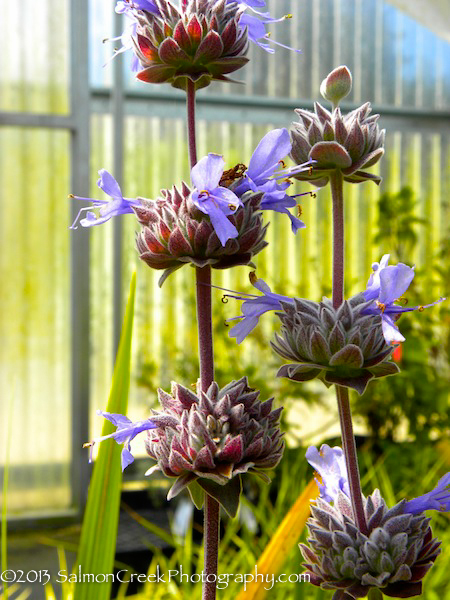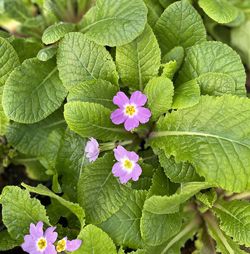
Salvia
Sage
Thought in ancient times to perpetuate good health, an Arab proverb asks, “How shall a man die with sage in his garden?” Our Salvias are diverse perennials, shrubs or subshrubs, many hailing from the Mediterranean, Mexico, South America and some of our western states. Reliable once established, and generally undaunted by pests, disease and drought, they combine an array of flowers and often aromatic foliage in many different sizes, shapes and hues.
Salvia clevelandii ‘Whirly Blue’ (P-1502)
OUT OF PRODUCTION AT THIS TIME
Email me when this plant is available

Native to southern California’s chaparral country and distinctive amongst the shrubby sages for its large deeper colored blossoms, you can usually smell this extremely long blooming, drought tolerant cultivar before it comes into view. The pleasantly sweet and woody aroma is a grace note to its handsome habit. Evergreen, narrow linear leaves have a pewter green tone, punctuated by a springtime flash of bright green stems. Excellent in dried arrangements, ‘Whirly Blue’s rich violet flower whorls, enhanced with dusky mulberry-colored calyxes, are favored by hummingbirds, bees and butterflies. Prune regularly to ensure an attractive appearance.
Blooms June – October.
Size: 4-1/2' high x 4' 0" – 5' 0" wide.
Hardy to zone 8.
Please fill out our Registration Form to receive news of updates to the web site, availability of new plants, give us your feedback, and to be on the mailing list to receive future printed catalogs.
Other selections in this genus:
- Salvia x ‘Allen Chickering’
- Salvia argentea
- Salvia arizonica
- Salvia azurea ‘Grandiflora’
- Salvia azurea ‘Nekan’
- Salvia ‘Bee’s Bliss’
- Salvia x ‘Big Swing’
- Salvia brandegeei ‘Pacific Blue’
- Salvia cacaliifolia
- Salvia chiapensis
- Salvia clevelandii ‘Winnifred Gilman’
- Salvia confertiflora
- Salvia corrugata
- Salvia ‘El Cielo Blue’
- Salvia ‘Eveline’
- Salvia forsskaolii
- Salvia glechomifolia
- Salvia greggii ‘Lowry’s Peach’
- Salvia x ‘Nuevo Leon’
- Salvia greggii ‘Wild Thing’
- Salvia guaranitica ‘Black and Blue’
- Salvia guaranitica ‘Blue Ensign’
- Salvia holwayi
- Salvia involucrata ‘Hidalgo’
- Salvia involucrata ‘Mulberry Jam’
- Salvia x jamensis ‘Pat Vlasto’
- Salvia leucantha x elegans ‘Anthony Parker’
- Salvia ‘Madeline’
- Salvia melissodora (Yucca Do Form)
- Salvia mexicana ‘Compton’s Form’
- Salvia mexicana ‘Limelight’
- Salvia mexicana ‘Tula’
- Salvia microphylla
- Salvia microphylla ‘Dennis’ Pink’
- Salvia microphylla x greggii ‘Red Velvet’
- Salvia microphylla ‘Hoja Grande’
- Salvia microphylla ‘San Carlos Festival’
- Salvia microphylla ‘Wild Watermelon’
- Salvia moorcroftiana ssp. x indica
- Salvia nemorosa ‘Amethyst’
- Salvia nemorosa ‘Blue Marvel’
- Salvia nemorosa ‘Caradonna’
- Salvia nemorosa ‘Midnight Rose’
- Salvia nemorosa ‘Negrito’
- Salvia nemorosa ‘Rosenwein’
- Salvia nemorosa ‘Sensation Deep Rose’
- Salvia nemorosa ‘Wesuwe’
- Salvia nemorosa ‘Schwellenburg’
- Salvia nubicola
- Salvia nutans
- Salvia ‘Phyllis Fancy’
- Salvia ‘Pozo Blue’
- Salvia pratensis ‘Sky Dance’
- Salvia pratensis ‘Swan Lake’
- Salvia pratensis ‘Sweet Esmeralda’
- Salvia pratensis ‘Twilight Serenade’
- Salvia przewalskii
- Salvia ‘Purple Majesty’
- Salvia purpurea ‘Lavender Lace’
- Salvia reptans
- Salvia reptans ‘West Texas Form’
- Salvia sclarea ‘Vatican White’
- Salvia semiatrata
- Salvia ‘Silke’s Dream’
- Salvia sinaloensis
- Salvia x sylvestris ‘Dear Anja’
- Salvia x sylvestris ‘Tanzerin’
- Salvia uliginosa
- Salvia ‘Ultra Violet’
- Salvia urica
- Salvia vanhoutii (Burgundy Form)
- Salvia verticillata ‘Purple Rain’
- Salvia ‘Waverly’











